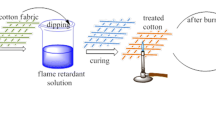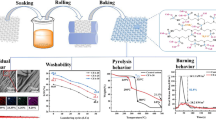Abstract
Due to the depletion of oil resources and the implementation of carbon-neutral strategies, pursuit of natural material-based flame retardants with high-durability flame retardancy has become an increasingly important issue. In this work, a small molecular phosphoramidate/ammonium phosphate flame retardant for cotton fabrics was synthesized with natural materials phytic acid and l-lysine, which was characterized by phosphorous-31 nuclear magnetic resonance and Fourier-transform infrared (FTIR) spectroscopy. Limiting oxygen index (LOI), vertical combustion, cone calorimetry, and durability tests showed that the finished sample had outstanding flame retardancy and superb washing resistance. LOI of the treated fabric at a weight gain of only 17% was 50.7%, and remained at 38.3% after 50 laundering times under AATCC 61-2013 3A standard. Thermogravimetric and thermogravimetric-infrared measurements proposed that the flame retardants primarily promoted char formation of cellulose and performed a condensation phase flame-retardant mechanism. FTIR and X-ray photoelectron spectroscopy results showed that the flame retardants grafted onto cellulose by N–P(=O)–O–C covalent bonds. Surface micromorphology and energy-dispersive X-ray analyses showed that flame retardants were evenly distributed in cotton, and with little metal ions remained after washing, indicating that the stable phosphoramidate maintained its flame retardancy. The whiteness and softness retention after modification were significantly improved.
Graphical abstract







Similar content being viewed by others
Data availability
Data will be made available on request.
References
Alongi J, Poskovic M et al (2012) Cyclodextrin nanosponges as novel green flame retardants for PP, LLDPE and PA6. Carbohydr Polym 88:1387–1394. https://doi.org/10.1016/j.carbpol.2012.02.038
Alongi J, Carletto RA, Di Blasio A et al (2013) DNA: a novel, green, natural flame retardant and suppressant for cotton. J Mater Chem A 1:4779–4785. https://doi.org/10.1039/c3ta00107e
Alongi J, Di Blasio A, Milnes J et al (2015) Thermal degradation of DNA, an all-in-one natural intumescent flame retardant. Polym Degrad Stab 113:110–118. https://doi.org/10.1016/j.polymdegradstab.2014.11.001
Bevington C, Williams AJ, Guider C et al (2022) Development of a flame retardant and an organohalogen flame retardant chemical inventory. Sci Data 9:1–10. https://doi.org/10.1038/s41597-022-01351-0
Bosco F, Carletto RA, Alongi J et al (2013) Thermal stability and flame resistance of cotton fabrics treated with whey proteins. Carbohydr Polym 94:372–377. https://doi.org/10.1016/j.carbpol.2012.12.075
Chen Y, Liao Y, Wan C et al (2022) Synthesis of a novel P–N reactive ammonium phosphate-based flame retardant for durable finishing of cotton fabric. Colloids Surf Physicochem Eng Asp 634:127967. https://doi.org/10.1016/j.colsurfa.2021.127967
Chen Y, Liao Y, Zhang G, Zhang F (2022) Durable flame-retardant finishing of cotton with a reactive phosphorus-based environmental flame retardant durable flame-retardant finishing of cotton with a reactive phosphorus-based environmental flame retardant. J Nat Fibers 19:15126–15138. https://doi.org/10.1080/15440478.2022.2070327
Cheng C, Lu Y, Cai J et al (2022) Ammonium polyphosphate surface-modified with l-lysine as an intumescent flame retardant for epoxy resin. Polym Adv Technol 33:534–545. https://doi.org/10.1002/pat.5535
De Chirico A, Armanini M, Chini P et al (2003) Flame retardants for polypropylene based on lignin. Polym Degrad Stab 79:139–145. https://doi.org/10.1016/S0141-3910(02)00266-5
De Saxce M, Pesnel S, Perwuelz A (2012) LCA of bed sheets - some relevant parameters for lifetime assessment. J Clean Prod 37:221–228. https://doi.org/10.1016/j.jclepro.2012.07.012
Ding D, Liu Y, Lu Y et al (2022) Highly effective and durable P–N synergistic flame retardant containing ammonium phosphate and phosphonate for cotton fabrics. Polym Degrad Stab 200:109964. https://doi.org/10.1016/j.polymdegradstab.2022.109964
Feng Y, Zhou Y, Li D et al (2017) A plant-based reactive ammonium phytate for use as a flame-retardant for cotton fabric. Carbohydr Polym 175:636–644. https://doi.org/10.1016/j.carbpol.2017.06.129
He S, Gao Y, Zhao Z et al (2021) Fully Bio-based phytic acid : basic amino acid salt for flame. Retardant Polypropyl. https://doi.org/10.1021/acsapm.0c01356
Isarov SA, Lee PW, Towslee JH et al (2016) DNA as a flame retardant additive for low-density polyethylene. Polymer (Guildf) 97:504–514. https://doi.org/10.1016/j.polymer.2016.05.060
Kitadai N, Yokoyama T, Nakashima S (2009) In situ ATR-IR investigation of l-lysine adsorption on montmorillonite. J Colloid Interface Sci 338:395–401. https://doi.org/10.1016/j.jcis.2009.06.061
Lazar S, Eberle B, Bellevergue E, Grunlan J (2020) Amine salt thickening of intumescent multilayer flame retardant treatment. Ind Eng Chem Res 59:2689–2695. https://doi.org/10.1021/acs.iecr.9b06359
Liao Y, Chen Y, Wan C et al (2021) An eco-friendly N[sbnd]P flame retardant for durable flame-retardant treatment of cotton fabric. Int J Biol Macromol 187:251–261. https://doi.org/10.1016/j.ijbiomac.2021.07.130
Liao Y, Chen Y, Zhang F (2021) A biological reactive flame retardant for flame retardant modification of cotton fabric. Colloids Surf Physicochem Eng Asp 630:127601. https://doi.org/10.1016/j.colsurfa.2021.127601
Liu X, Zhang Q, Cheng Wen B et al (2018) Durable flame retardant cellulosic fibers modified with novel, facile and efficient phytic acid-based finishing agent. Cellulose 25:799–811. https://doi.org/10.1007/s10570-017-1550-0
Liu J, Dong C, Zhang Z et al (2020) Durable flame retardant cotton fabrics modified with a novel silicon–phosphorus–nitrogen synergistic flame retardant. Cellulose 27:9027–9043. https://doi.org/10.1007/s10570-020-03370-9
Liu X, Zhang Q, Peng B et al (2020b) Flame retardant cellulosic fabrics via layer-by-layer self-assembly double coating with egg white protein and phytic acid. J Clean Prod. https://doi.org/10.1016/j.jclepro.2019.118641
Liu Y, Ding D, Lu Y et al (2022) Efficient and durable cotton fabric surface modification via flame retardant treatment. Colloids Surf Physicochem Eng Asp 648:129005. https://doi.org/10.1016/j.colsurfa.2022.129005
Lu Y, He Q, Chen Y, Zhang G (2022) Synthesis of triethylenetetramine phosphonate ammonium flame retardant and its application to cotton fabrics. Cellulose 29:2107–2118. https://doi.org/10.1007/s10570-022-04416-w
Lu Y, Zhao P, Chen Y et al (2022) A bio-based macromolecular phosphorus-containing active cotton flame retardant synthesized from starch. Carbohydr Polym 298:120076. https://doi.org/10.1016/j.carbpol.2022.120076
Lu Y, Lu Y, Yang Y et al (2023) Synthesis and application of a novel high durable cotton flame retardant rich in P[sbnd]N covalent bonds and ammonium phosphate groups. Chem Eng J 454:140422. https://doi.org/10.1016/j.cej.2022.140422
Miao Z, Yan D, Zhang T et al (2021) High-efficiency flame retardants of a P–N-rich polyphosphazene elastomer nanocoating on cotton fabric. ACS Appl Mater Interfaces 13:32094–32105. https://doi.org/10.1021/acsami.1c05884
Mohsin M, Ahmad SW, Khatri A, Zahid B (2013) Performance enhancement of fire retardant finish with environment friendly bio cross-linker for cotton. J Clean Prod 51:191–195. https://doi.org/10.1016/j.jclepro.2013.01.031
Morgan AB (2019) The future of flame retardant polymers–unmet needs and likely new approaches. Polym Rev 59:25–54. https://doi.org/10.1080/15583724.2018.1454948
Pan H, Wang W, Shen Q et al (2016) Fabrication of flame retardant coating on cotton fabric by alternate assembly of exfoliated layered double hydroxides and alginate. RSC Adv 6:111950–111958. https://doi.org/10.1039/c6ra21804k
Proto M, Supino S, Malandrino O (2000) Cotton: a flow cycle to exploit. Ind Crops Prod 11:173–178. https://doi.org/10.1016/S0926-6690(99)00060-6
Sykam K, Försth M, Sas G et al (2021) Phytic acid: a bio-based flame retardant for cotton and wool fabrics. Ind Crops Prod 164:113349. https://doi.org/10.1016/j.indcrop.2021.113349
Thota S, Somisetti V, Kulkarni S et al (2020) Covalent functionalization of cellulose in cotton and a nylon-cotton blend with phytic acid for flame retardant properties. Cellulose 27:11–24. https://doi.org/10.1007/s10570-019-02801-6
Wang B, Li P, Xu YJ et al (2020) Bio-based, nontoxic and flame-retardant cotton/alginate blended fibres as filling materials: thermal degradation properties, flammability and flame-retardant mechanism. Compos Part B Eng 194:108038. https://doi.org/10.1016/j.compositesb.2020.108038
Wu X, Gou T, Zhao Q et al (2022) High-efficiency durable flame retardant with ammonium phosphate ester and phosphine oxide groups for cotton cellulose biomacromolecule. Int J Biol Macromol 194:945–953. https://doi.org/10.1016/j.ijbiomac.2021.11.149
Xu F, Zhang G, Wang P, Dai F (2021) A novel ε-polylysine-derived durable phosphorus-nitrogen‐based flame retardant for cotton fabrics. Cellulose 28:3807–3822. https://doi.org/10.1007/s10570-021-03714-z
Xu F, Zhang G, Wang P, Dai F (2022) Durable and high-efficiency casein-derived phosphorus-nitrogen-rich flame retardants for cotton fabrics. Cellulose 29:2681–2697. https://doi.org/10.1007/s10570-022-04430-y
Yang H, Yu B, Xu X et al (2020) Lignin-derived bio-based flame retardants toward high-performance sustainable polymeric materials. Green Chem 22:2129–2161. https://doi.org/10.1039/d0gc00449a
Yang X, Liu X, Yang X et al (2022) A phosphorous/nitrogen-containing flame retardant with UV-curing for polyester/cotton fabrics. Cellulose 29:1263–1281. https://doi.org/10.1007/s10570-021-04346-z
Yang Y, Tang Q, Diao S et al (2023) Formaldehyde-free, high-durability flame retardant with phosphoramidite and reactive ammonium phosphoric acid for cotton fabrics. Cellulose. https://doi.org/10.1007/s10570-023-05512-1
Zhang Y, Tian W, Liu L et al (2019) Eco-friendly flame retardant and electromagnetic interference shielding cotton fabrics with multi-layered coatings. Chem Eng J 372:1077–1090. https://doi.org/10.1016/j.cej.2019.05.012
Zhang F, Lu Y, Wan C et al (2020) A bio-resourced mannitol phospholipid ammonium reactive flame retardant for cotton with efficient antiflaming and durability. Cellulose 27:4803–4815. https://doi.org/10.1007/s10570-020-03064-2
Zhang AN, Zhao HB, Cheng JB et al (2021) Construction of durable eco-friendly biomass-based flame-retardant coating for cotton fabrics. Chem Eng J 410:128361. https://doi.org/10.1016/j.cej.2020.128361
Zhang S, Chu F, Xu Z et al (2021) Interfacial flame retardant unsaturated polyester composites with simultaneously improved fire safety and mechanical properties. Chem Eng J 426:131313. https://doi.org/10.1016/j.cej.2021.131313
Acknowledgments
This work was financially supported by the Chongqing Postgraduate Research Innovation Project of Chongqing Education Commission of China (Grant No. CYB23137), and the Graduate Innovation Project of Southwest University (Grant No. SWUS23113).
Funding
This work was financially supported by the Chongqing Postgraduate Research Innovation Project of Chongqing Education Commission (Grant No. CYB23137), and the Graduate Innovation Project of Southwest University (Grant No. SWUS23113).
Author information
Authors and Affiliations
Contributions
YL: Methodology, formal analysis, investigation, data curation, Writing—original draft. QT and YY: Software, investigation. LX: Editing, validation. GZ: Resources and review.
Corresponding author
Ethics declarations
Conflict of interest
The authors declare that they have no competing financial interests or personal relationships that could have appeared to influence the work reported in this paper.
Ethics approval and consent to participate
Comply with ethical standards.
Consent for publication
The manuscript has been approved for publication by all authors.
Additional information
Publisher’s Note
Springer Nature remains neutral with regard to jurisdictional claims in published maps and institutional affiliations.
Electronic supplementary material
Below is the link to the electronic supplementary material.
Rights and permissions
Springer Nature or its licensor (e.g. a society or other partner) holds exclusive rights to this article under a publishing agreement with the author(s) or other rightsholder(s); author self-archiving of the accepted manuscript version of this article is solely governed by the terms of such publishing agreement and applicable law.
About this article
Cite this article
Lu, Y., Tang, Q., Yang, Y. et al. Highly durable phosphoramidate/ammonium phosphate flame retardant for cellulose textile from natural materials: phytic acid and l-lysine. Cellulose 31, 2635–2650 (2024). https://doi.org/10.1007/s10570-023-05728-1
Received:
Accepted:
Published:
Issue Date:
DOI: https://doi.org/10.1007/s10570-023-05728-1




